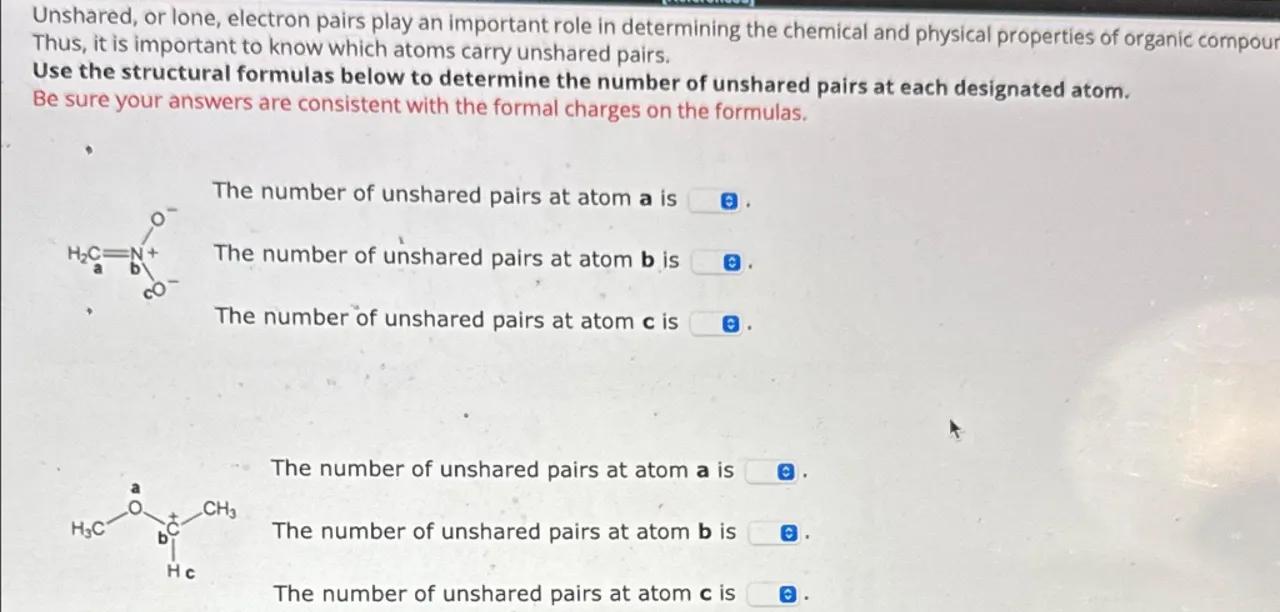
Sia
Unshared, or lone, electron pairs play an important role in determining the chemical and physical properties of organic compour Thus, it is important to know which atoms carry unshared pairs.
Use the structural formulas below to determine the number of unshared pairs at each designated atom.
Be sure your answers are consistent with the formal charges on the formulas.
The number of unshared pairs at atom is The number of unshared pairs at atom is The number of unshared pairs at atom is The number of unshared pairs at atom is The number of unshared pairs at atom is
The number of unshared pairs at atom is 

Answer from Sia
Posted over 1 year ago
Solution
1
Determine the number of unshared pairs for atom a (nitrogen): Nitrogen typically forms three bonds and has one unshared pair of electrons to satisfy the octet rule. Given that nitrogen is triple-bonded to carbon and carries a positive charge, it has no unshared pairs of electrons
2
Determine the number of unshared pairs for atom b (central carbon): Carbon forms four bonds to satisfy the octet rule. In this molecule, carbon is triple-bonded to nitrogen and double-bonded to oxygen, which accounts for all four bonds without any unshared pairs of electrons
3
Determine the number of unshared pairs for atom c (oxygen): Oxygen typically forms two bonds and has two unshared pairs of electrons to satisfy the octet rule. Given that oxygen is double-bonded to carbon and carries a negative charge, it has one unshared pair of electrons
4
Determine the number of unshared pairs for atom a (oxygen in the second molecule): Oxygen typically forms two bonds and has two unshared pairs of electrons. Since it is single-bonded to carbon, it has three unshared pairs of electrons
5
Determine the number of unshared pairs for atom b (carbon in the second molecule): Carbon forms four bonds to satisfy the octet rule. Since it is bonded to one oxygen and three hydrogen atoms, it has no unshared pairs of electrons
6
Determine the number of unshared pairs for atom c (carbon in the second molecule): This carbon is identical to atom b, bonded to one oxygen and three hydrogen atoms, and also has no unshared pairs of electrons
1 Answer
The number of unshared pairs at atom is 0
The number of unshared pairs at atom is 0
The number of unshared pairs at atom is 1
2 Answer
The number of unshared pairs at atom is 3
The number of unshared pairs at atom is 0
The number of unshared pairs at atom is 0
Key Concept
Unshared pairs of electrons are determined by the octet rule and the bonding preferences of atoms in molecules.
Explanation
Nitrogen with a positive charge has no unshared pairs, carbon with four bonds has no unshared pairs, and oxygen with a negative charge has one unshared pair in the first molecule. In the second molecule, oxygen with a single bond has three unshared pairs, while both carbons with four bonds have no unshared pairs.
Not the question you are looking for? Ask here!
Enter question by text
Enter question by image
Unlock Smarter Learning with AskSia Super!
Join Super, our all-in-one AI solution that can greatly improve your learning efficiency.
30% higher accuracy than GPT-4o
Entire learning journey support
The most student-friendly features
Study Other Question
